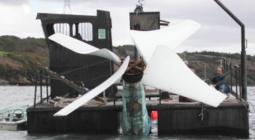Tidal barrier proposal for Lincolnshire and Norfolk sets off wave of opposition

Plans for a renewable energy tidal barrier linking Norfolk and Lincolnshire have sparked fierce debate between scientists, wildlife charities and a port company CEO who is leading the project.
Entrepreneur James Sutcliffe, who has managed and advised port companies in Sierra Leone and Bangladesh, has now set his sights on the Wash, which is the sea, mudflats and salt marsh between the two counties.
The proposed project would include a port, powered by tidal energy, which Sutcliffe says would create electricity for 600,000 homes and businesses in the region. He claims it would also create the potential for cruise-ship tourism and a new road that links Lincolnshire to Norfolk in 20 minutes.
Sutcliffe says the calm waters created by the tidal barrier would provide opportunities for “marinas and construction of desirable waterside developments” as well as “safe sailing”, and that the construction would protect the local environment from flooding.
In his confidential pitch for investment, he claims to have government support: “We have received strong, albeit informal, institutional support for the core development and do not anticipate difficulty in securing the development capital at a time when renewable energy projects are so topical in government after Cop26 and sought after by major financial institutions.”
However, the plans for the stunning and ecologically important stretch of coastline, which is home to a globally important colony of seals and many rare wading birds, are hugely controversial in the local area.
Tammy Smalley, from Lincolnshire Wildlife Trust, said: “Having grown up and lived around the Wash all my life, I know just what a special place it is and the vital service it provides to communities.
“As a natural flood defence, a source of food and a wild place to visit, it should be protected at all costs – not destroyed to generate obscenely expensive energy and increase the risk of flooding.”
Dominic Buscall, who runs the Wild Ken Hill nature reserve in north Norfolk, said: “His wildlife claims are supported by no evidence, and that’s a recurring theme. He has made countless baseless claims about the benefits of this proposal, and I think his so-called concern for nature is totally insincere.
“The way the Wash works is it’s quite a dynamic wilderness, so you get very complex movements of water and sediment which creates a mosaic of mudflats, salt marsh, channels, tidal streams … and that is what makes it so great for wildlife. Over 2 million birds visit a year, it hosts 50% of Europe’s common seals, and it has eels which are critically endangered globally. To interfere with those processes is highly likely to be very damaging.”
Buscall believes the project is “highly unlikely to go ahead”, but added “we mustn’t be complacent. Frankly speaking, the Wash is non-compensable. The birds, rather than going to a new habitat, would starve and die.”
Some scientists who are in support of renewable energy say the ecological risks of this project outweigh any clean power benefits.
Doug Parr, chief scientist for Greenpeace UK, said: “In the middle of a climate and nature emergency we need clean energy developments that work in harmony with nature without damaging it further. Tidal energy may have a useful role to play, particularly energy from tidal currents, but a barrage has been tried in UK before and the costs and level of ecological damage were not encouraging.
“Greenpeace remains highly sceptical that a tidal barrage on the Wash is a useful project, and it should certainly not be a priority for government support. Given the environmental impacts, needs for port infrastructure or flood defence should be met in a more targeted way.”
Critics note that a similar development along the River Severn was dismissed by a House of Commons select committee in 2013 as “prohibitively expensive”. The development was later cancelled on economic grounds.
However, Chris Binnie, a visiting professor at the University of Exeter and a tidal barrier consultant, said it could work.
He said: “The mean spring tide tidal range at Hunstanton, close to the barrage, is 6.5 metres. This is lower than normal for tidal range schemes but should enable a reasonable amount of tidal range energy to be provided. Tidal power is predictable, and largely indigenous, and is a further source of renewable tidal power which should be welcomed.”
Binnie said he believes ecological damage could be mitigated: “Tidal range turbines can operate in both generation and pumping mode so basin water levels can be controlled. Thus it should be possible to largely replicate bird feeding areas, an important factor in this sensitive area.”
Sutcliffe said: “Our mission is to maintain the Wash boundaries and its ecology, which will otherwise be badly impacted by more intense climate-change enhanced storm surges which, in time, could overtop the current sea defences and flood the Fens and south Lincolnshire, which sit at just 1 or 2 metres above sea level depending on where you live.
“Sea level is predicted to rise by 33cm in the next two generations, so adding to this impact. The rise in sea level could also flood the valuable wildlife feeding and wading areas in the Wash.”
cover photo: The Wash is a stunning and ecologically important stretch of coastline between Lincolnshire and Norfolk. Photograph: Nature Picture Library/Alamy




